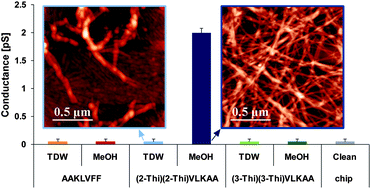Conductance of amyloid β based peptide filaments: structure–function relations†
Abstract
Controlling the morphology of self-assembled peptide

* Corresponding authors
a
Department of Materials Engineering, Ben Gurion University of the Negev, Beer-Sheva, Israel
E-mail:
nurita@bgu.ac.il
b Department of Chemistry, University of Reading, Reading, UK
c The Ilse Katz Institute for Nanoscale Science and Technology, Ben Gurion University of the Negev, Beer-Sheva, Israel
Controlling the morphology of self-assembled peptide

 Please wait while we load your content...
Something went wrong. Try again?
Please wait while we load your content...
Something went wrong. Try again?
M. Amit, G. Cheng, I. W. Hamley and N. Ashkenasy, Soft Matter, 2012, 8, 8690 DOI: 10.1039/C2SM26017D
To request permission to reproduce material from this article, please go to the Copyright Clearance Center request page.
If you are an author contributing to an RSC publication, you do not need to request permission provided correct acknowledgement is given.
If you are the author of this article, you do not need to request permission to reproduce figures and diagrams provided correct acknowledgement is given. If you want to reproduce the whole article in a third-party publication (excluding your thesis/dissertation for which permission is not required) please go to the Copyright Clearance Center request page.
Read more about how to correctly acknowledge RSC content.
 Fetching data from CrossRef.
Fetching data from CrossRef.
This may take some time to load.
Loading related content
